| I figured that since I was doing so many water tests, I should run a few tests in liquids that aren't water. Trying to come up with four common non-water liquid, I decided to run test on fluids that were alcoholic, acidic, basic, and oily. That would cover lots of ground, anyway. For alcohol, I had arguably the most pure commercially available, legal alcohol... Everclear. At 95% alcohol, you can compare that in your mind to bathroom rubbing alcohol, which is typically a mere 70%. For acidic I used lemon-juice, which is apparently a pH of about 2 - 2.5. Unfortunately I don't at the moment have ammonia or bleach for a base, so I used a baking-soda solution, which should have a pH of about 9. Should I get some bleach sometime in the future, I may rerun the base test with that (pH of about 12.8). And for oil... olive oil. I decided to do multiple times submerged in the liquids as with the water tests, but kept it shorter in general. The lengths submerged were 2 seconds, 2 minutes, and 20 minutes. |
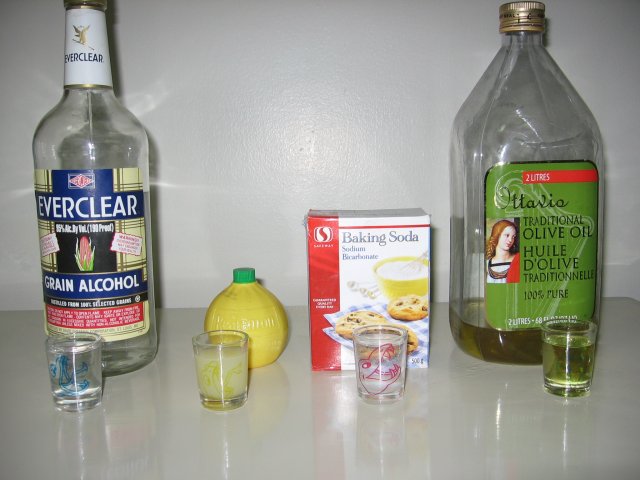
|
| Since Everclear evaporates ridiculously quickly, I decided to run that one first. I wrote a quick 'baseline' example with all four pens to begin with, and then dunked it under for 2 seconds. |
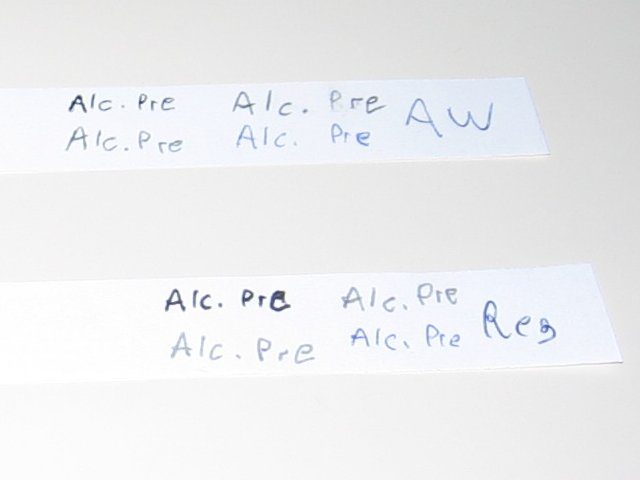 |
| And I've now learned that regular pen ink and alcohol do not get along. The pre-dunk ink had faded on both, but moreso on the all-weather. The gel slightly faded, and the rest were fine. It was almost impossible to write anything with ink or the black gel with alcohol still on the surface of the paper. The pencil strangely enough wrote even better than when the paper was dry. |
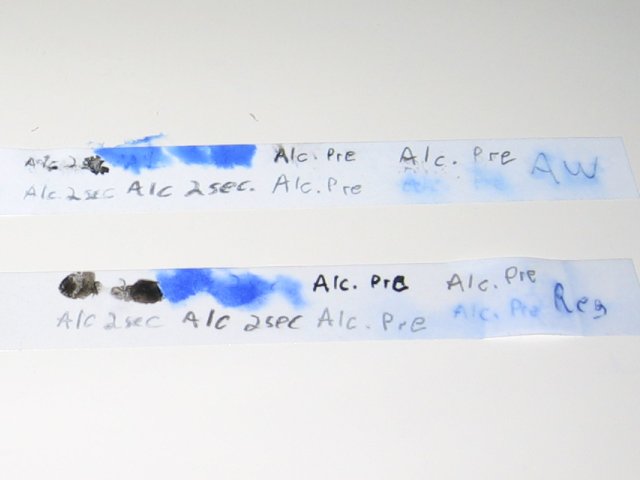 |
| After being submerged for 2 minutes, the original ink had all but disappeared on both. Even the "AW" and "Reg" that has been there for two days was pretty faded. The gel was faring a little bit better, but was still faded. I think more of the alcohol evaporated off the paper for this one, since I was able to write more clearely with all pens on both papers. Again, the pencil was still working better than ever. |
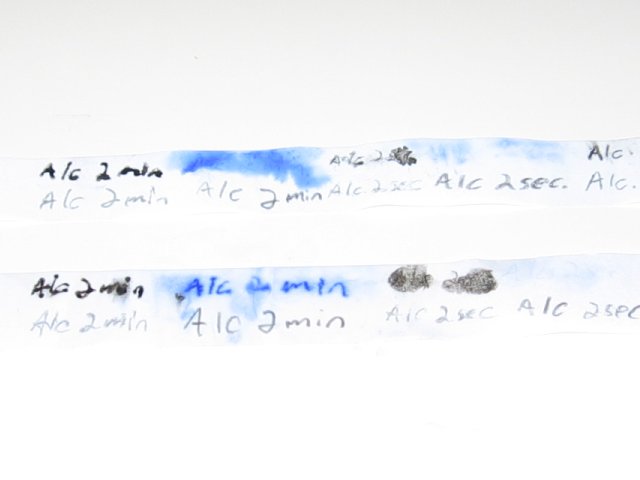 |
| After 20 minutes, all regular ink was all but gone, except the 2-day-old "AW" and "Reg". Surprisingly, the regular paper wasn't weakened in the slightest, and seemed just as strong as if it were new. Same with all-weather. The alcohol had definitely evaporated off a bit more before I got to write on it, as I could write almost perfectly clearly with all pens. The pen was horrible, followed by black-gel, mostly horrible. Silver ws next, doing fairly well except when writing on wet alcohol, followed by pencil, which wrote BETTER when in wet alcohol. This may well be the very first, and possibly the last test in which regular paper did BETTER than all-weather paper in all aspects. |
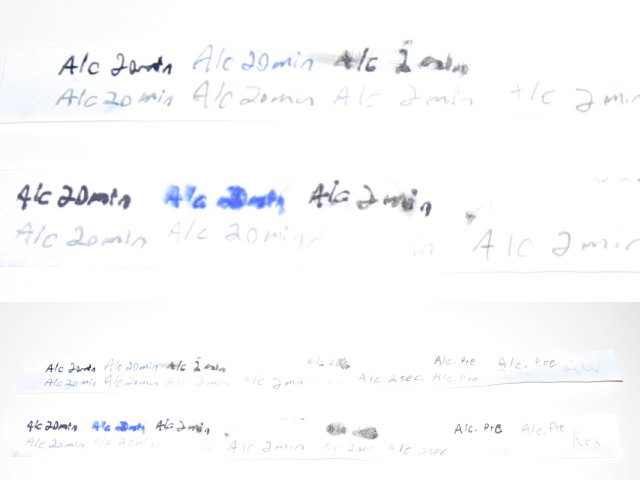
|
| Next up was the lemon juice. As with the alcohol, I wrote on the pages before dunking them under. |
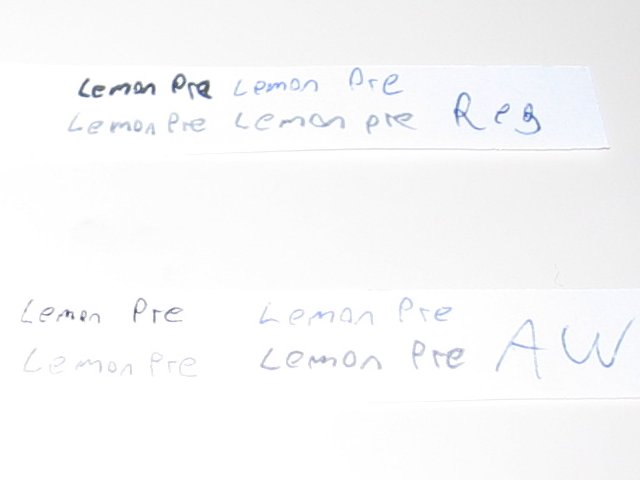 |
| Both papers did fairly well for 2 seconds. Both of them were writing fairly neatly with all pens, aside from the gel pen running into the puddles of lemon juice a bit. The previous ink barely attempted to run at all. The regular paper didn't soak through in 2 seconds, and thus was still relatively strong. The pencil however ripped it slightly. |
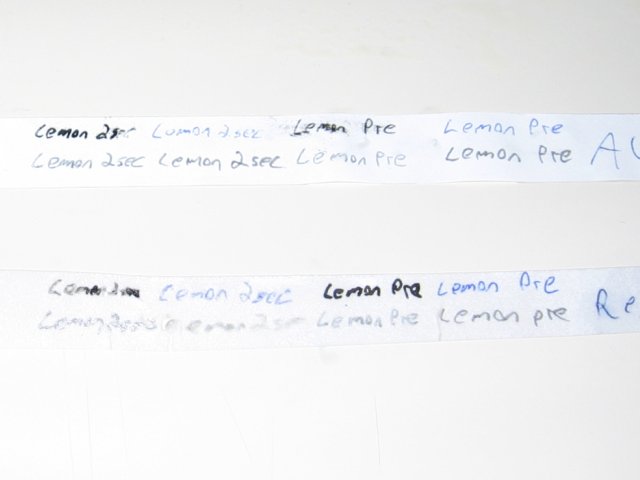 |
| The regular paper took a definite turn for the worse on this. After two minutes, it was soaked through, and seemed weaker than the 5-minute water test. Any writing attempts aside from the gel and silver pens ripped right through. The all-weather paper held up just fine, but with the silver pen having a bit of a hard time getting started. The gel pens seem to not enjoy writing in an acidic solution. |
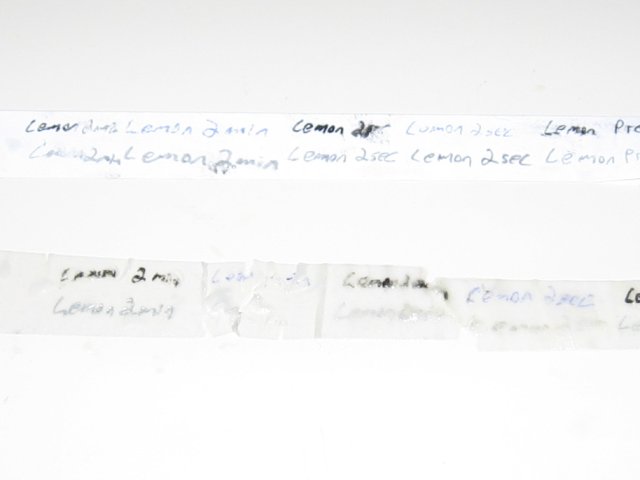 |
| After 20 minutes, the all-weather paper had mostly soaked through, and the regular paper was hell to try to flatten out. It was doing far worse than than expected, and the slightest touch would shred it. By far more damaging to it than water. The all-weather held on, although all ink and gel pens had a hard time getting going. The pencil did fine as per usual. I also ran out of room a bit, due to 'lemon' being a longer word than the rest. Only the gel pens could make a mark on the regular paper when done gently, and even THAT shredded it somewhat. |
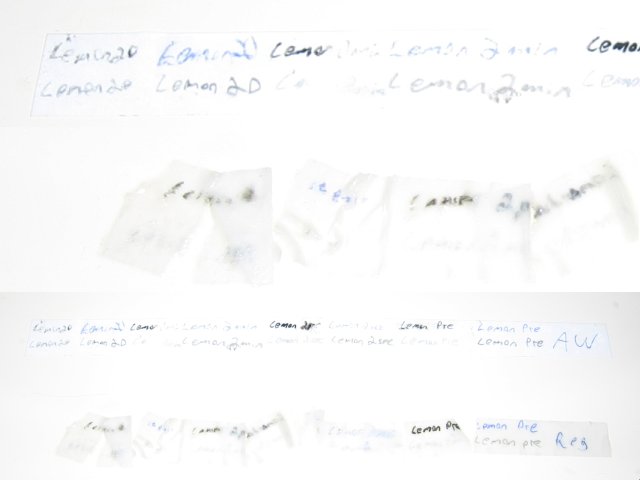
|
| Next up was the water saturated with baking-soda. It's only a pH of about 9, but hopefully it will at least do SOMETHING. At least until I get my hands on some bleach, anyway. |
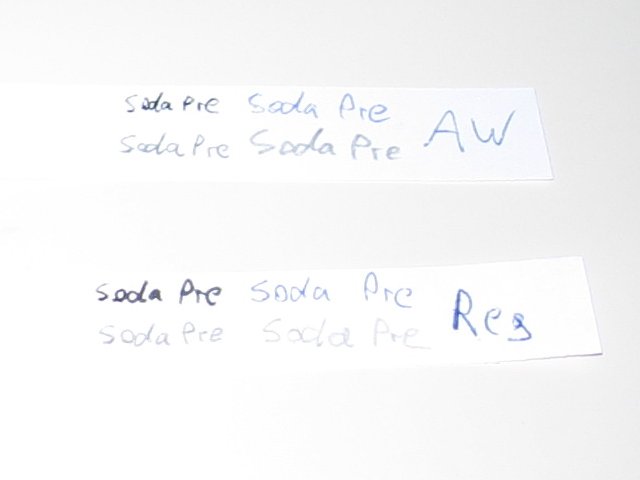 |
| The two-second dip was very similar to the 5-second water test. The regular paper fared a bit better, since it didn't quite soak through. Pencil, pen, and silver pen all wrote decently, and the gel pen bled into the liquid as expected. |
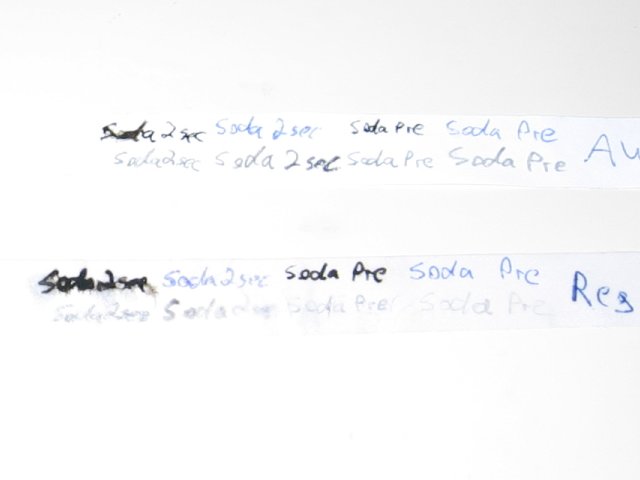 |
| The basic solution seemed to wash away most of the gel pens on the all-weather paper surprisingly, and made the regular pen bleed a bit. Writing on it at this point was about identical to the 2-second dunk. The regular paper was tearing pretty easily, and I could only get decent writing out of the silver pen. The gel pen bled into the paper deeply, moreso than when it was subermerged in just water for the wetness tests, and I could only make a few marks with the pen without it tearing. |
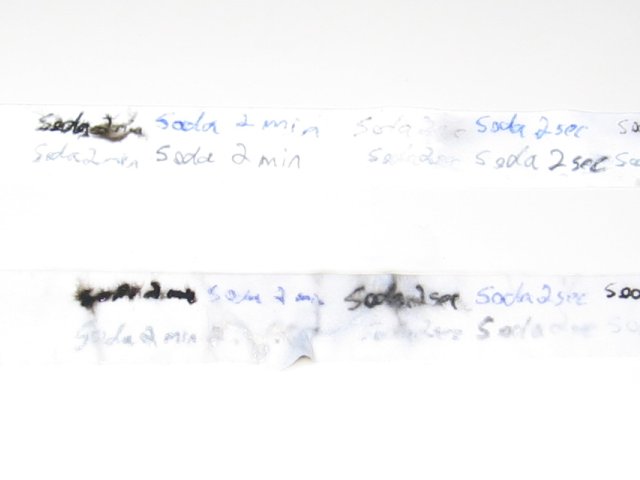 |
| Again, the baking-soda-water washed away most of the previous gel and silver ink on all-weather. Writing on it was about the same as with 2-minutes. The regular paper held up better than the 20-minute soak in lemon juice, and I could get it all and fairly well straightened. It broke in about 4 or 5 places, but I could make things visible. It definitely seemed to hold the gel ink a lot better than all-weather, but that's likely because it soaked into the paper more. Again, only the gel and silver pens could write at all on it. If I should get bleach, THEN we'll see how well that fibrous paper holds up. |
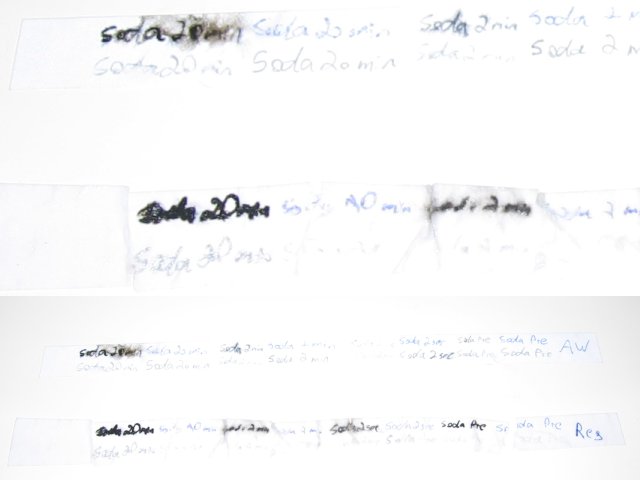
|
| This was without a doubt, by FAR the messiest test I've run to date. Not only did the oil seem to enjoy getting EVERYWHERE, it clung to everything and was hard to clean up. I soaped down the surface, the shotglass, and cleaned up the pen tips after every portion of this test. The results were quite surprising however. |
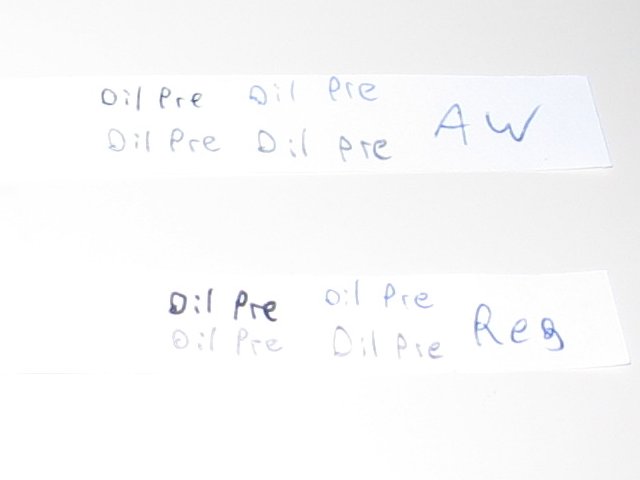 |
| The oil soaked entirely through the regular paper, and most-way through the all-weather paper in two seconds. There was a coating of oil over the paper that refused to leave as well at this point. It did little to the original inks, but made it extremely difficult to write on the all-weather paper. Only the pencil could but anything down... and better than when it was dry! On the regular paper, I could get legible writing with all four pens! Could this be a re-occurance of regular paper outperforming all-weather? |
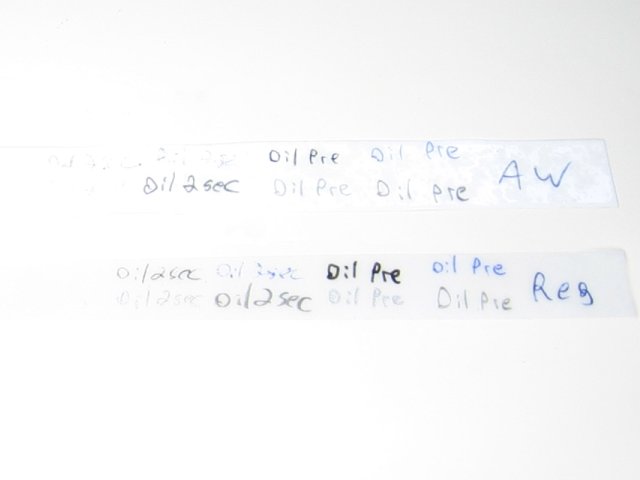 |
| After 2 minutes, the all-weather was entirely soaked through (except in one corner, which may have been above the surface or something). Only the pencil could write on it. It was futile with any other. The regular paper not only wasn't weak in the slightest, all pens were able to write at least SOMETHING on it. They were faded, but at least the tips of the pen were able to find enough grip to be able to write. The pencil was about the same on both. Regular paper is definitely in the lead here. |
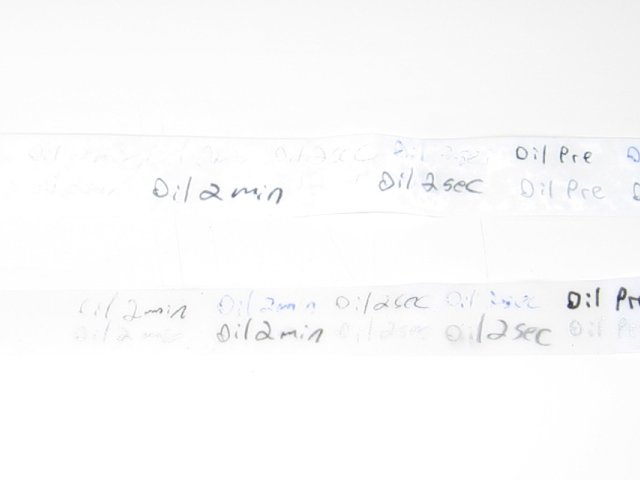 |
| After 20 minutes in the oil, the regular paper once again stood far above the all-weather. All pens were faded but readable, and pencil was the same. Neither paper was noticeably weakened, although they did put up a bit of a fight to get them to lie flat again. I got a hint of ink out of the gel pen on the all-weather paper, but it was negligiable. For the second time ever, regular copier paper outperforms all-weather paper. I would have to admit that they both tied on the pencil though. |
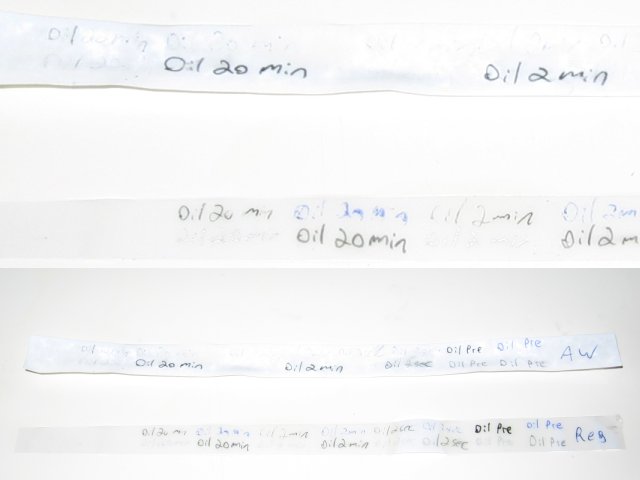
|
The extreme temperatures test | The multiple fluids test (part 2)
|
